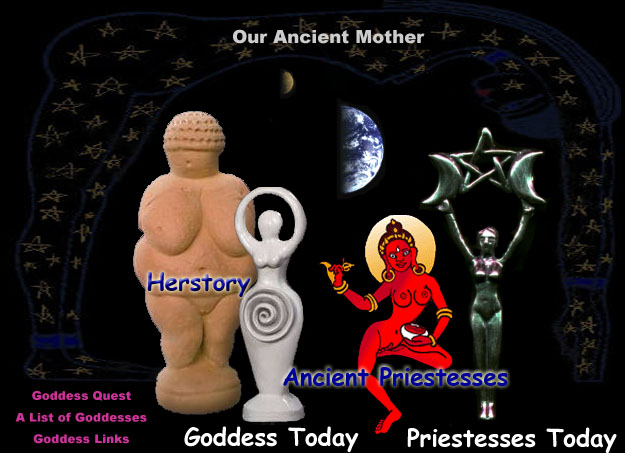Goddess of the Sun
Copyright © 2000-2003,
C. Osborne
http://www.1freespace.com/women/alexiares/Athena/atsun.html
e co
Greeks never called Athena a Sun Goddess outright, in fact they stubbornly maintained Apollo was the Sun deity, even when this had foolish results. Titling him 'Phoebas,' a feminine monicker which made him a 'lunar Sun' for example. There is plenty of evidence showing Athena was the original solar deity, however. The frequently appearing Gorgon-head Sun comes to mind first, but there are several specific features that can be examined. As explained by Patricia Monaghan54. they are: possession of a sacred mirror and glowing necklace, the invention of weaving, association with a dance of power, and having a companion Goddess who is a smith and/or shaman. Athena does indeed have a sacred mirror, although in Greek myth it has become a shield. Her glowing necklace has become the snaky aegis... the snake is often associated with the Sun's rays. Even the Greeks maintained that Athena invented weaving and was the very spirit of the craft. The famous Pyrrhic dance, centerpiece of the Athenian Panathenaea was performed in her honour.
Snakes are interwoven with a great deal of provocative symbolism. Their coiling bodies suggested the spiral, itself used to represent the Sun and the eyes of the Goddess. The coiled snake also suggests the coiled thread Athena used while weaving, and the ball of thread Ariadne used to escape the labyrinth. Athena is related to Ariadne by being a psychompomp, a role already mentioned in the main section in speaking of a small statue of Athena found in an Attic tomb with snakes for arms.
Sun Goddesses were frequently psychopompes, and the labyrinth was itself connected to the Sun. It's entrance was carefully faced East to catch the first sunlight of the day. Patricia Monaghan's research has also shown that the labyrinth accurately charts the Sun's path in the sky in the far North. Travelling the labyrinth made rebirth possible, whether if be by the Goddess leading the dead from its centre beneath the ground, or the priestess Ariadne guiding initiates through it for a spiritual rebirth. Winding up the thread originally recreated the globe of the Sun, rebirthing the Sun Goddess herself. The ubiquitous pools near labyrinths or Cretan Goddess temples were probably meant to act as mirrors. The Sun's reflection was used for divination, rather than the endless circling of the fish.
All of Athena's temples and any sacrifices had to include fire in some way, be it by the eternal flame tended only by old women, burning incense, or burning the sacrifice itself. Women regularly used lenses to start altar fires, as they did their fires at home, and still had this duty in the days of the Roman Empire. The burning lenses were also used to cauterize wounds, and so they were also sacred to Athena as Goddess of healing. The hot springs Athena heated as she travelled in the underworld at night in her solar boat were also dedicated to her healing aspect. This was done most famously at the Celto-Romanic shrine of Minerva Sulis, Minerva being the Roman Goddess Athena ultimately absorbed.
The Sun Goddess was protected, encouraged to stay during the winter, and encouraged to remain benign in summer in many ways. Spirals invoking her and mirroring her beauty were carved and embroidered everywhere, still pools and bronze mirrors did so literally. Some version of Cat's Cradle may have been played by Greek children to hold the Sun in the sky, or perhaps provide a new set of reins for her chariot, in case the originals broke or became tangled. Dancing moonwise during the day was strictly prohibited for fear of weakening the Sun. To insure Athena reappeared in the morning, her priestesses performed a variety of mysterious nightly rituals.
Bronze mirrors were sacred to Athena from an early date, as they were to many Sun Goddesses, from Maat to Amaterasu. The cave of Aralokhori South of Knossos on Crete was one of Athena's sanctuaries as well as a bronzesmith's shop. Which points back to the question of where the expected shaman Goddess companion is.
There is such a Goddess in Greek myth, named Baubo or Iambe, who brings Demeter out of her misery and allows Persephone to return from the underworld by dancing laciviously, crowning the striptease with the exposure of her genitals. 'Persephone' can be translated 'destroyer of all' or 'she who shines for all' and is one of Athena's alternate names. The labrys is an abstracted rendition of the female labia. Cowries and triangles were both sacred because they resembled a woman's genitals and were symbols of Athena. Both her rival Poseidon and the enemy of her Amazons Belleropheron were sent running in terror by the sight of a line of women marching on them with genitals ritually exposed. Today female genitals are still considered powerful literally and symbolically... in some of today's more overtly patriarchal cultures, men are taught that seeing a woman's genitals will strike them blind. Apparently the rebirth of the Sun Goddess was considered a difficult and dangerous time, demanding the most powerful magical measures to assist.
None of this is to suggest worshippers of Demeter and Persephone considered the latter identical to Athena, or even that one is somehow directly derived from the other. Rather, elements of their worship were probably similar, and the confusion over Baubo's name is in fact an accidental preservation of the name of Athena's companion Goddess of smithing and shamanism, Iambe.
In 'O Mother Sun: A New View of the Cosmic Feminine.'
This page last updated: 03/01/2018
